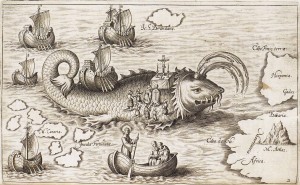Chapter 3. The Transatlantic Age
3.1 Introduction

The 1400s witnessed the start of increasingly ambitious sea expeditions in the Atlantic and the Indian Oceans, which continued for several centuries. Countries in Eurasia and Africa developed a growing interest in exotic goods and the wider world. The western European voyages of fishermen, whalers, and licensed explorers opened up an era in which the growth of commerce, creed, and curiosity combined with an opportunity to exploit new resources in far-off lands. Different European nations used different strategies to achieve these goals.
The motivations of the European expansionists were those of their age. The pursuit of material and spiritual goals reflected the agendas of mercantile wealth accumulation and Catholic dominance. The example of Iberian colonies in Mexico, the Caribbean, and South America taunted the French: they, too, wanted easy riches and an almost effortless conquest. Instead they got long, cold winters, an Iroquois adversary that would not relent, and a trade in furs — a far cry from the silver and gold looted from the Aztec and Incan empires. As well, the French experiment in North America faced serious competition from English and Dutch Protestants in the region.
In the earliest era of contact and conquest, the Spanish dominated the New World. Their experiences largely defined early European knowledge of the Americas and its native inhabitants, the people Europeans called los Indios or “Indians.” In the 50 years after Christopher Columbus’s first voyage across the Atlantic in 1492, the Spanish established the basis for a powerful hemispheric empire. The Spanish faced two significant challenges, however: distance and time. The long journey between Europe and the colonies meant that communication was difficult and slow. Distance and time played a key role in shaping colonial administration as well as patterns and methods of imperial control.
The direct impact of European exploration on the northern half of North America was slight until the early 17th century, with colonization and some measure of agricultural settlement occurring only very slowly. The earlier successes modelled by the Spanish and Portuguese from the Carolinas south to Tierra del Fuego had a profound effect on European attitudes and ambitions for the lands to the north.
This chapter surveys early European interest in what was called the “Americas” through the first stages of establishing colonies. It explores the various economic and political models that emerged, and the impact of this phase of transatlantic plunder on the emergence of western Europe as a centre of imperial power.
Learning Objectives
Type your learning objectives here.
- Account for the European incursion into the western Atlantic.
- Describe the factors that made European exploration and expansion possible.
- Identify the ideas and attitudes that provide the intellectual context for the “age of exploration.”
- Account for the presence of the French in North America.
- Explain the evident failure of Cartier’s expeditions.
Attributions
Figure 3.1
Wikinger by Rdnk is in the public domain.

